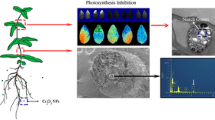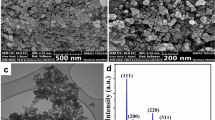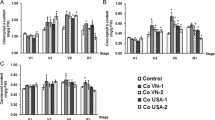Abstract
Cerium oxide nanoparticles (CeO2 NPs) are widely used in industries and have caused environmental problems. However, the phytotoxicity induced by CeO2 NPs lacks detailed information on phytotoxicity. In this research, the effect of CeO2 NPs on soybean plants (Glycine max) was studied. Scanning electron microscopy with the energy dispersion spectroscopy was used to characterize the NPs form in soybean. The growth of the root was increased, whereas the growth of shoot was inhibited. Besides, Chlorophyll Fluorescence Imager (CF Imager) showed that chlorophyll synthesis was inhibited: the maximum quantum yield of Photosystem II complex (PSII) (Fv/Fm) and photochemical quenching (qP) decreased. Moreover, transmission electron microscopy revealed that the chloroplast thylakoid structure was changed, and thus reduced the energy conversion in the Calvin cycle from C5 to C3. Our work suggests that CeO2 NPs will cause growth changes as well as irreversible damage to soybean plants. Our findings will provide evidence for estimation of plant toxicity induced by CeO2 NPs.




Similar content being viewed by others
References
Adams J, Wright M, Wagner H, Valiente J, Britt D, Anderson A (2017) Cu from dissolution of CuO nanoparticles signals changes in root morphology. Plant Physiol Biochem 110:108–117
Andersen CP, King G, Plocher M, Storm M, Pokhrel LR, Johnson MG et al (2016) Germination and early plant development of ten plant species exposed to TiO2 and CeO2 nanoparticles. Environ Toxicol Chem 35(9):2223–2229
Baker NR, Rosenqvist E (2004) Applications of chlorophyll fluorescence can improve crop production strategies: an examination of future possibilities. J Exp Bot 55(403):1607–1621
Chowdhury A, Maiti SK (2016) Identification of metal tolerant plant species in mangrove ecosystem by using community study and multivariate analysis: a case study from Indian Sunderban. Environ Earth Sci 75:744. https://doi.org/10.1007/s12665-016-5391-1
Chua H (1998) Bio-accumulation of environmental residues of rare earth elements in aquatic flora Eichhornia crassipes (Mart.) Solms in Guangdong Province of China. Sci Total Environ 214(1–3):79–85
Dekani L, Johari SA, Joo HS (2019) Comparative toxicity of organic, inorganic and nanoparticulate zinc following dietary exposure to common carp (Cyprinus carpio). Sci Total Environ 656:1191–1198
Deng F, Wang S, Xin H (2016) Toxicity of CuO nanoparticles to structure and metabolic activity of Allium cepa root tips. Bull Environ Contam Toxicol 97(5):702–708
Ebbs SD, Bradfield SJ, Kumar P, White JC, Musante C, Ma X (2016) Accumulation of zinc, copper, or cerium in carrot (Daucus carota) exposed to metal oxide nanoparticles and metal ions. Environ Sci 3(1):114–126
Gutiérrez-Boem FH, Thomas GW (2001) Leaf area development in soybean as affected by phosphorus nutrition and water deficit. J Plant Nutr 24(11):1711–1729
Hawthorne J, De la Torre Roche R, Xing B, Newman LA, Ma X, Majumdar S, White JC (2014) Particle-size dependent accumulation and trophic transfer of cerium oxide through a terrestrial food chain. Environ Sci Technol 48(22):13102–13109
Hernandez-Viezcas JA, Castillo-Michel H, Andrews JC, Cotte M, Rico C, Peralta-Videa JR, Gardea-Torresdey JL (2013) In situ synchrotron X-ray fluorescence mapping and speciation of CeO2 and ZnO nanoparticles in soil cultivated soybean (Glycine max). ACS Nano 7(2):1415–1423
Holden PA, Klaessig F, Turco RF, Priester JH, Rico CM, Avila-Arias H, Gardea-Torresdey JL (2014) Evaluation of exposure concentrations used in assessing manufactured nanomaterial environmental hazards: are they relevant? Environ Sci Technol 48(18):10541–10551
Kim JH, Lee Y, Kim EJ, Gu S, Sohn EJ, Seo YS, Chang YS (2014) Exposure of iron nanoparticles to Arabidopsis thaliana enhances root elongation by triggering cell wall loosening. Environ Sci Technol 48(6):3477–3485
Kim S, Samanta P, Yoo J, Kim WK, Jung J (2017) Time-dependent toxicity responses in Daphnia magna exposed to CuO and ZnO nanoparticles. Bull Environ Contam Toxicol 98(4):502–507
Kohan-Baghkheirati E, Geisler-Lee J (2015) Gene expression, protein function and pathways of Arabidopsis thaliana responding to silver nanoparticles in comparison to silver ions, cold, salt, drought, and heat. Nanomaterials 5(2):436–467
Li J, Song Y, Vogt RD, Liu Y, Luo J, Li T (2020) Bioavailability and cytotoxicity of Cerium-(IV), Copper-(II), and Zinc oxide nanoparticles to human intestinal and liver cells through food. Sci Total Environ 702:134700
López-Moreno ML, de la Rosa G, Hernández-Viezcas JA, Peralta-Videa JR, Gardea-Torresdey JL (2010) X-ray absorption spectroscopy (XAS) corroboration of the uptake and storage of CeO2 nanoparticles and assessment of their differential toxicity in four edible plant species. J Agric Food Chem 58(6):3689–3693
Ma C, White JC, Dhankher OP, Xing B (2015) Metal-based nanotoxicity and detoxification pathways in higher plants. Environ Sci Technol 49(12):7109–7122
Missaoui T, Smiri M, Chemingui H, Jbira E, Hafiane A (2018) Regulation of mitochondrial and cytosol antioxidant systems of Fenugreek (Trigonella foenum graecum L.) exposed to nanosized titanium dioxide. Bull Environ Contam Toxicol 101(3):326–337
Murchie EH, Lawson T (2013) Chlorophyll fluorescence analysis: a guide to good practice and understanding some new applications. J Exp Bot 64(13):3983–3998
Naz A, Chowdhury A, Mishra BK, Karthikeyan K (2018) Distribution of heavy metals and associated human health risk in mine, agricultural and roadside soils at the largest chromite mine of India. Environ Geochem Health 40(5):2155–2175
Née Röhder LAK, Brandt T, Sigg L, Behra R (2018) Uptake and effects of cerium (III) and cerium oxide nanoparticles to Chlamydomonas reinhardtii. Aqua Toxicol 197:41–46
Perreault F, Oukarroum A, Pirastru L, Sirois L, Matias WG, Popovic R (2010) Evaluation of copper oxide nanoparticles toxicity using chlorophyll a fluorescence imaging in lemna gibba. J Bot 2010(4):807–826
Priester JH, Ge Y, Mielke RE, Horst AM, Moritz SC, Espinosa K, Schimel JP (2012) Soybean susceptibility to manufactured nanomaterials with evidence for food quality and soil fertility interruption. PNAS 109(37):E2451–E2456
Rajput VD, Minkina T, Sushkova S, Mandzhieva S, Fedorenko A, Lysenko V, Chaplygin V (2019) Structural and ultrastructural changes in nanoparticle exposed plants. In: Nanoscience for sustainable agriculture. Springer, Cham, pp 281–295
Redondo-Gómez S, Mateos-Naranjo E, Moreno FJ (2010) Physiological characterization of photosynthesis, chloroplast ultrastructure, and nutrient content in bracts and rosette leaves from glaucium flavum. Photosynthetica 48(4):488–493
Roche RDLT, Pagano L, Majumdar S, Eitzer BD, Zuverza-Mena N, Ma C, White JC (2018) Co-exposure of imidacloprid and nanoparticle Ag or CeO2 to Cucurbita pepo (zucchini): contaminant bioaccumulation and translocation. NanoImpact 11:136–145
Sendra M, Yeste PM, Moreno-Garrido I, Gatica JM, Blasco J (2017) CeO2 NPs, toxic or protective to phytoplankton? Charge of nanoparticles and cell wall as factors which cause changes in cell complexity. Sci Total Environ 590:304–315
Slack CR, Hatch MD, Goodchild DJ (1969) Distribution of enzymes in mesophyll and parenchyma-sheath chloroplasts of maize leaves in relation to the C4-dicarboxylic acid pathway of photosynthesis. Biochem J 114(3):489–498
Tanino R, Amano Y, Tong X, Sun R, Umemoto J, Kobayashi M, Hotta T (2019). Therapeutic efficacy of zinc oxide nanoparticles against small cell lung cancer in an Orthotopic Xenograft Model. In: B68. Oncogenic mutations, MET
Wang Z, Xu L, Zhao J, Wang X, White JC, Xing B (2016) CuO Nanoparticle interaction with Arabidopsis thaliana: toxicity, parent-progeny transfer, and gene expression. Environ Sci Technol 50(11):6008–6016
Weryszko-Chmielewska E, Chwil M (2005) Lead-induced histological and ultrastructural changes in the leaves of soybean (Glycine max (L.) Merr.). Soil Sci Plant Nutr 51(2):203–212
Wild E, Jones KC (2009) Novel method for the direct visualization of in vivo nanomaterials and chemical interactions in plants. Environ Sci Technol 43(14):5290–5294
Yang Z, Chen J, Dou R, Gao X, Mao C, Wang L (2015) Assessment of the phytotoxicity of metal oxide nanoparticles on two crop plants, maize (Zea mays L.) and rice (Oryza sativa L.). Int J Environ Res Public Health 12(12):15100–15109
Yang X, Pan H, Wang P, Zhao FJ (2017) Particle-specific toxicity and bioavailability of cerium oxide (CeO2) nanoparticles to Arabidopsis thaliana. J Hazard Mater 322:292–300
Zhang W, Huang Y, Gong H, Dang F, Zhou D (2019) Different uptake of metal dioxide nanoparticles (ceria nanoparticles, zirconia nanoparticles and silica nanoparticles) by Wheat. Bull Environ Contam Toxicol 1–7.
Acknowledgements
This study was financially supported by the National Natural Science Foundation of China (#41271333, #21477104, #41671315).
Author information
Authors and Affiliations
Corresponding author
Additional information
Publisher's Note
Springer Nature remains neutral with regard to jurisdictional claims in published maps and institutional affiliations.
Electronic supplementary material
Below is the link to the electronic supplementary material.
Rights and permissions
About this article
Cite this article
Li, J., Mu, Q., Du, Y. et al. Growth and Photosynthetic Inhibition of Cerium Oxide Nanoparticles on Soybean (Glycine max). Bull Environ Contam Toxicol 105, 119–126 (2020). https://doi.org/10.1007/s00128-020-02892-z
Received:
Accepted:
Published:
Issue Date:
DOI: https://doi.org/10.1007/s00128-020-02892-z




